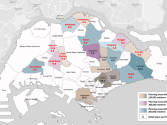
World Bank gives nod to India's $625m loan for solar programme
At least 400MW of GRPV will be installed across India.
The World Bank Board approved a $625 million loan to support the Government of India’s program to generate electricity from widespread installation of rooftop solar photo-voltaic (PV). The Board also approved a co-financing loan of $120 million on concessional terms and a $5 million grant from Climate Investment Fund’s (CIF) Clean Technology Fund.
The project will finance the installation of at least 400 MW of Grid Connected Rooftop Solar Photovoltaic (GRPV) across India. These solar PV installations will provide clean, renewable energy, and reduce greenhouse gas emissions by displacing thermal generation. The project will also strengthen the capacity of key institutions, and support the development of the overall solar PV market.
The project will be implemented by the State Bank of India (SBI). SBI will on-lend funds to solar PV developers/aggregators and end-users, who wish to invest in mainly commercial and industrial rooftop PV systems. Financing will be provided to those with sound technical capacity, relevant experience, and creditworthiness as per SBI standards.
India is one of the lowest per capita consumers of electricity in the world. Over 200 million people remain unconnected to the electricity grid, and those who are, continue to face frequent disruptions. Power shortages also affect industrial output with many industries and manufacturers relying on expensive and polluting diesel-based back-up power supplies.
Despite energy shortages, and the high cost of backup supply, rooftop solar PV systems have not yet become widespread in India. This is primarily due to the lack of adequate financing, unfamiliar technology and low consumer awareness. Until now, those that wanted to install solar rooftop PV systems had to pay the full cost up-front. The total capacity of rooftop solar, therefore, remains low.
This IBRD-CIF loan has been designed to tackle a number of these barriers, develop the market for rooftop solar PV systems, and ensure that their use becomes much more widespread.
Aided by government policy and declining costs, rooftop solar has the potential to transform the energy sector. The overall potential demand for rooftop solar is estimated at about 124,000 MW.
“India is endowed with huge solar energy potential, and the World Bank is strongly supportive of the government’s plans to harness this potential and increase India’s solar PV capacity to 100 GW. This project will support this target, by providing financing to some of the 40 GW of solar PV which will be placed on rooftops,” said Onno Ruhl, World Bank Country Director in India. “Solar PV will not only improve access to electricity, but it will do so in a manner that avoids the environmental impacts of other traditional electricity sources. Through this project and others like it, tens of millions of electricity customers will eventually be able to generate part of their own electricity needs, from one of the cleanest sources of energy,” he added.
The IBRD-CIF loan will support a number of solar PV business models, to expand the reach of rooftop PV systems to a variety of customer groups. Some customers can afford to develop and own their rooftop systems, whereas others prefer the pay-to-use model, without outright ownership. Accordingly, the range of options available to investors under the SBI Rooftop PV Program will include third-party ownership, leasing, rooftop rental, as well as direct end-user ownership.
“Today, the only available option for those who want to install solar PV is to pay the entire cost up-front. The variety of financing mechanisms on offer under this program will represent a major innovation for the rooftop market. Most importantly, the scope of the project will go beyond simply making finance available, it will also improve the investment climate for solar PV, and increase the `Ease of Doing Rooftop Business’,” said Mohua Mukherjee, Senior Energy Specialist and World Bank’s Task Team Leader for the project.
The loan, from the International Bank for Reconstruction and Development (IBRD), has a 19.5 year grace period, and a maturity of 20 years. Loan from CIF’s Clean Technology Fund, has a 10 year grace period, and a maturity of 40 years.























 Advertise
Advertise







